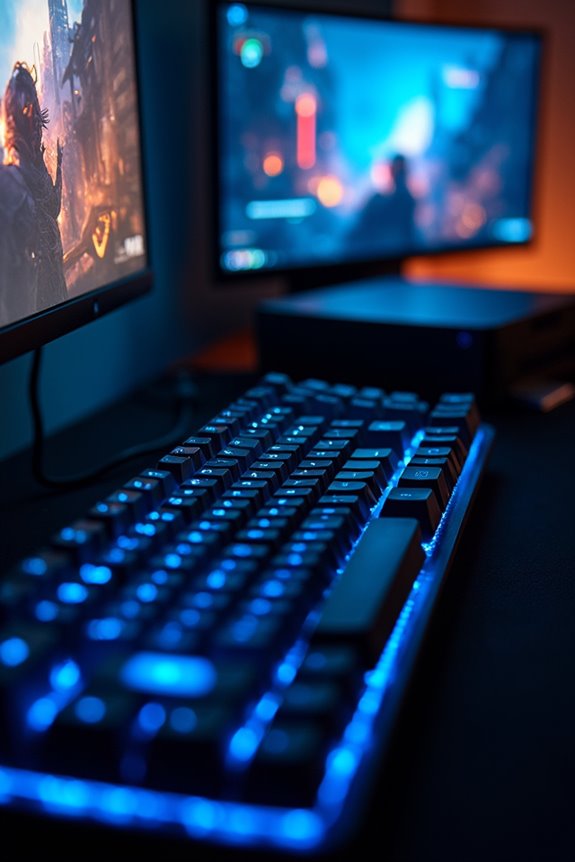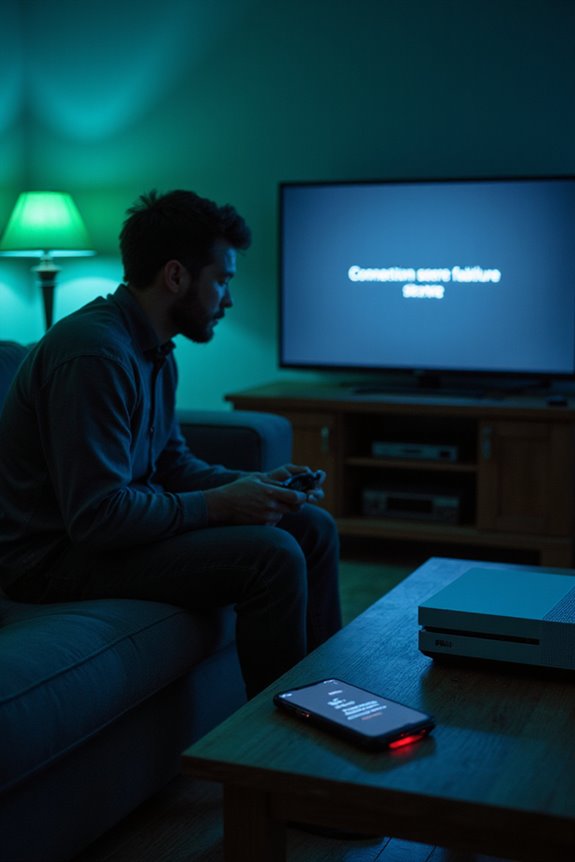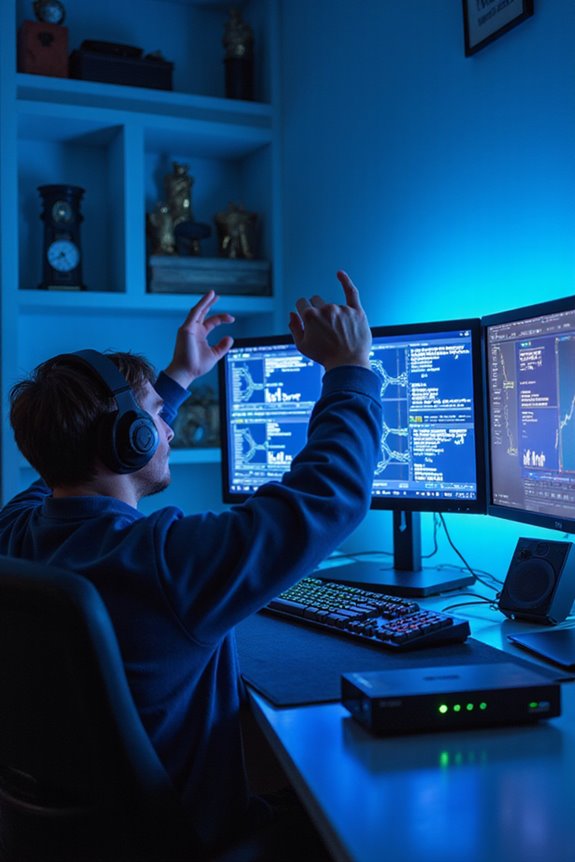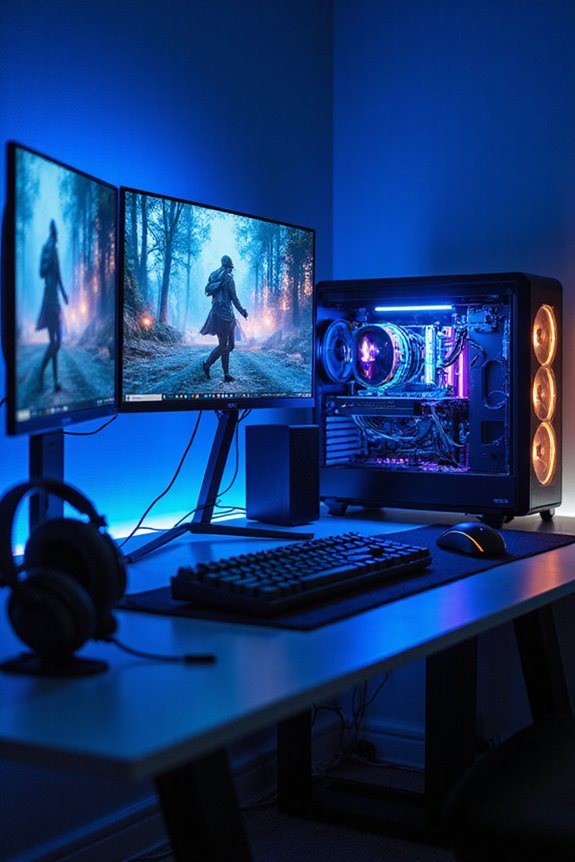To banish internet lag during gaming, I focus on optimizing my connection. A wired Ethernet setup keeps latency low and stability high, which is essential for responsive gameplay. Monitoring my internet speed and prioritizing gaming traffic via QoS settings on my router guarantees a smoother experience. I also select servers close to my location to minimize ping. By managing my network traffic and making these adjustments, I can greatly enhance my gaming sessions, and there’s more to explore on this topic!
Key Takeaways
- Use a wired Ethernet connection for unmatched stability and lower latency compared to wireless options, enhancing your gaming experience.
- Prioritize gaming traffic with Quality of Service (QoS) settings on your router to reduce lag during gameplay.
- Select game servers closest to your location to minimize latency and improve connection performance.
- Play during off-peak hours to experience reduced global server traffic and enhanced connection stability.
- Regularly monitor your internet speed, latency, and bandwidth usage to identify and address potential connectivity issues.
Understanding Network Congestion and Its Impact on Gaming
When you’re deep into a gaming session, the last thing you want is to be thwarted by network congestion. It happens when the demand for network resources exceeds capacity, leading to frustrating lags and potential disconnections. High traffic volumes, especially during peak hours or major game launches, can overwhelm even the best setups.
I’ve felt that sting when the game freezes, and I realize it’s due to too many users hogging the bandwidth. While strategies like traffic prioritization and network optimization can help, it’s essential to choose an ISP with robust infrastructure. Remember, a well-maintained network can make all the difference between a seamless experience and a frustrating one. So, let’s keep those connections flowing smoothly!
Identifying Latency Issues and How They Affect Performance
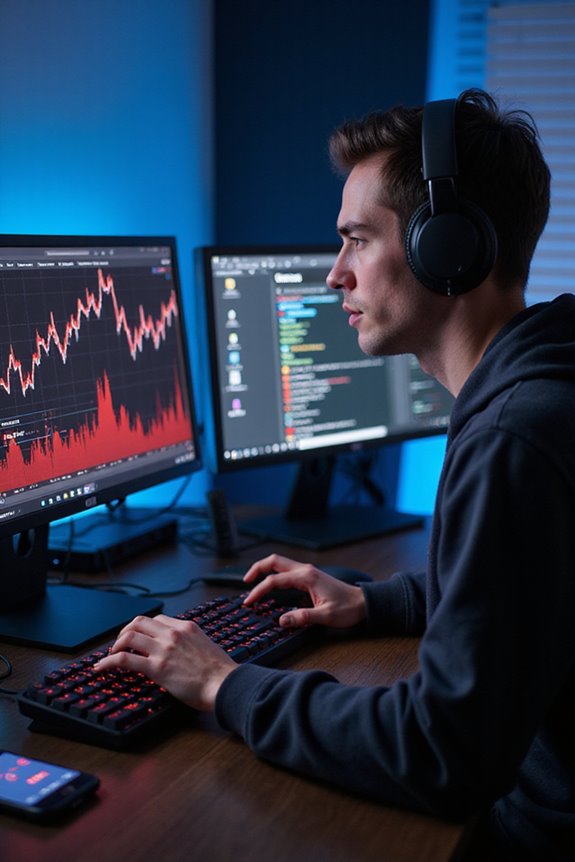
Identifying latency issues is crucial if you want to elevate your gaming performance. It can feel frustrating when your commands don’t register as you expect. Input latency, for instance, is the time it takes from your button press to when your PC processes it. Then there’s display latency, which delays the moment you see your action on-screen. Tools like NVIDIA Reflex and AMD Frame Latency Meter can help measure these delays. Wireless devices often add extra latency, while high-refresh-rate monitors can reduce display lag considerably. Remember, even background processes can slow things down. Monitors with AMD FreeSync or NVIDIA G-Sync can also help eliminate screen tearing and stuttering during gameplay. Understanding these factors will not only enhance your experience but also give you an edge in competitive play. Let’s dive deeper into optimizing your setup next!
The Benefits of Wired Connections for Gaming Stability
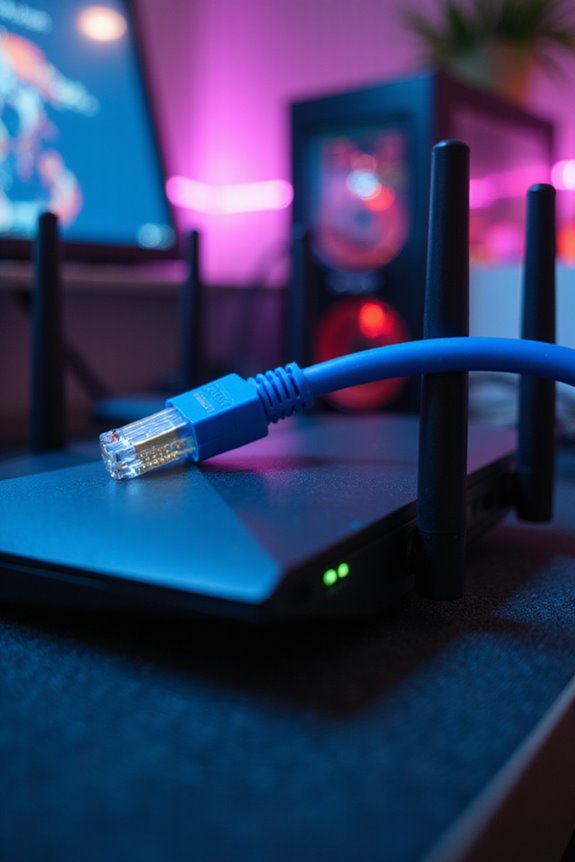
While I appreciate the convenience of wireless connections, I’ve found that wired connections truly shine when it comes to gaming stability. The stability and reliability of a wired Ethernet connection are simply unmatched. I love how it guarantees a consistent data flow, reducing the risk of lag spikes. Plus, with lower latency, my real-time responses are greatly better, which is vital in competitive gaming.
Wired connections also sidestep interference from other devices, providing a clearer pathway for data. Sure, setting up cables can be a bit of a hassle, but the payoff is worth it. When every millisecond counts, the performance boost feels like a secret weapon in my gaming arsenal. So, if you’re serious about gaming, consider going wired!
Assessing Your Internet Speed for Optimal Gaming
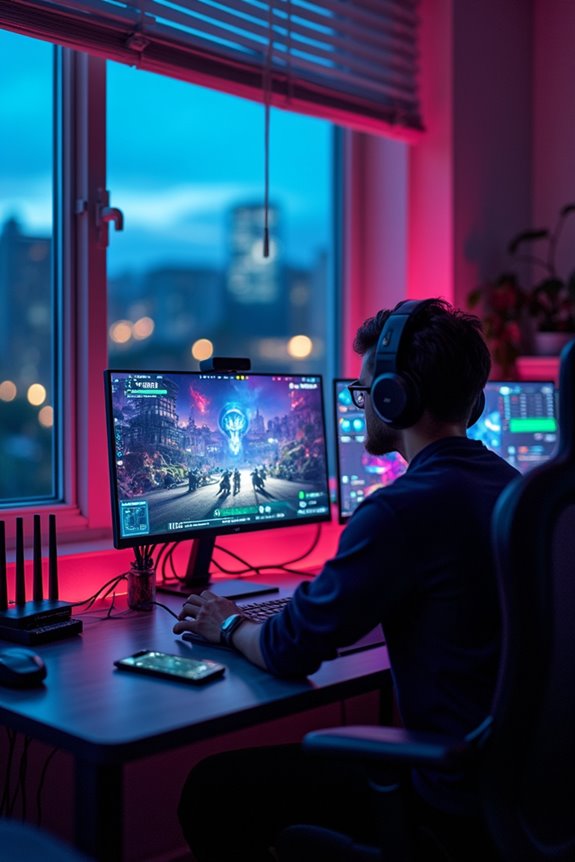
Have you ever wondered how your internet speed affects your gaming experience? It’s essential to assess your download and upload speeds, as a higher download speed means quicker data reception, while upload speed influences your voice chat quality. I check my latency, or ping, because low latency guarantees responsive gameplay, and I keep an eye on jitter to maintain a smooth connection. Using reliable speed test tools like Ookla or Cloudflare helps me get accurate metrics. Remember, factors like network congestion or distance from servers can impact your performance. So, if you’re serious about gaming, take some time to assess these elements for a better experience. After all, a stable connection can make all the difference!
Techniques to Optimize Your Gaming Connection
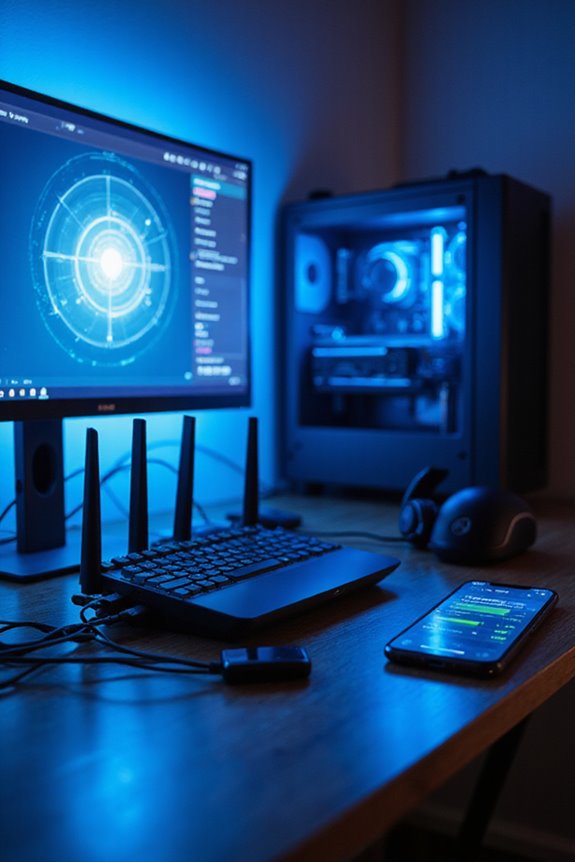
When it comes to optimizing your gaming connection, there are several techniques that can greatly enhance your experience. First, I recommend using Quality of Service (QoS) settings on your router. By prioritizing gaming traffic, you can reduce lag and guarantee smoother gameplay. Don’t forget to configure your router to include your gaming devices in the priority list.
Also, consider investing in high-speed fiber-optic connections and upgrading your router hardware. Regularly monitoring bandwidth usage helps identify where improvements can be made. Finally, limit connected devices while gaming. It’s pretty straightforward—by managing your network wisely, you’ll enjoy a more stable and responsive gaming experience. Trust me, it’s worth the effort!
Managing Your Network Environment for Better Performance
To get the most out of your gaming experience, managing your network environment is essential. Upgrading to a fiber-optic connection can drastically reduce latency, giving you that edge in competitive play. I’ve found that wired Ethernet connections are a game-changer too; they provide stability and lower latency compared to Wi-Fi.
Choosing the right ISP is just as important—look for one with high-speed plans and minimal data caps. I also recommend optimizing your Ethernet cables; investing in quality ones can prevent pesky signal loss. And if you stick to the 5GHz band for Wi-Fi, you’ll dodge a lot of interference. It’s all about creating a seamless environment so you can focus on what really matters: the game.
Software Tweaks to Enhance Gaming Experience
While diving into the world of gaming, it’s crucial to contemplate how software tweaks can greatly enhance your experience. For instance, tools like Hone and Razer Cortex can boost your FPS, making gameplay smoother without you lifting a finger. SG TCP Optimizer optimizes TCP/IP settings, reducing latency and packet loss—vital for those intense online matches.
Then there’s NetBalancer, which lets you prioritize gaming traffic, ensuring your game gets the bandwidth it needs. Don’t forget about ExpressVPN; it not only secures your connection but can also stabilize it against pesky DDoS attacks. While these tools can genuinely enhance your gaming, remember to check compatibility and ease of use. After all, nobody wants to wrestle with complicated software mid-game!
Advanced Troubleshooting for Persistent Lag Issues
Persistent lag issues can be frustrating, especially when you’re deep into a game and the action slows to a crawl. To tackle this, I often restart my modem and router, which can really clear up connectivity hiccups. Switching to a wired connection offers more stability than Wi-Fi, making a noticeable difference in performance. Also, I make sure my Wi-Fi router is centrally placed to enhance coverage and minimize interference.
If you’re still facing lag, consider adjusting your network settings, like enabling QoS to prioritize gaming traffic. Don’t forget to check your network adapter for issues, and a bit of port forwarding might just be the magic touch you need. Trust me, these tweaks can transform your gaming experience!
The Importance of Regular Hardware and Software Updates
Keeping your gaming experience smooth goes beyond just troubleshooting connectivity issues; it also hinges on maintaining your hardware and software. Regular updates can greatly enhance performance, optimizing resource usage and resolving pesky bugs. You’ll notice smoother operation, and who doesn’t love new features that make gaming even more enjoyable?
Security is another key benefit. Updates patch vulnerabilities, protecting your system from emerging threats and keeping your data safe. Plus, they help extend your hardware’s lifespan by optimizing its performance, which means less frequent replacements and a kinder impact on your wallet.
Investing a little time in updates helps future-proof your setup, ensuring everything remains compatible with the latest advancements. HDR technology enhances contrast and color vibrancy, providing an enriched visual experience that further elevates your gaming setup. Trust me, your gaming experience will thank you!
Choosing the Right Gaming Server for Reduced Latency
When you’re diving into the world of online gaming, picking the right server can make a world of difference. I’ve found that choosing a server location close to me greatly reduces latency since data travels shorter distances. Many games let you select your server region, which is a real bonus for lowering ping. It’s also smart to play during off-peak hours when global server traffic is lighter.
Using wired connections, like fiber optic, tends to offer the best speeds and lower latency than wireless options. Finally, I’ve learned that utilizing server selection tools can help pinpoint the best server based on latency and location, ensuring a smoother gaming experience overall.
Frequently Asked Questions
How Does Weather Affect My Internet Connection Speed?
Imagine a stormy night, and I’m huddled in my cozy blanket, frustrated as my internet slows. Weather impacts my connection, causing disruptions from rain, wind, and even power outages, making online tasks feel like a crawl.
Can Using a VPN Reduce or Increase Lag?
I’ve found that using a VPN can either reduce or increase lag, depending on server location and load. It’s worth experimenting with different options to see what works best for your gaming experience.
Does My Gaming Console Impact Internet Lag?
Absolutely, your gaming console can impact internet lag. I’ve noticed that older hardware struggles with modern games, and sometimes, a simple firmware update can make all the difference in improving my gaming experience.
How Can I Identify Background Applications Causing Lag?
Have you ever wondered why your game’s lagging? I use Task Manager to peek at resource-hungry background apps. It helps me figure out what to close, freeing up my system for smoother gaming sessions.
What Is the Role of Firmware Updates in Reducing Lag?
Firmware updates play an essential role in reducing lag. I’ve noticed they fix bugs, improve device communication, and enhance performance. Keeping everything updated really makes a difference, ensuring smoother gaming experiences for me.

